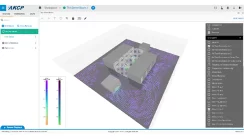AKCP Devices Enhanced with Two Factor Authentication Security
To maintain its position as one of the leading environmental monitoring solutions manufacturers for server room and data centre applications, AKCP has introduced Two Factor Authentication (2FA) to its sensorProbe+ range of monitoring devices. This latest development reinforces AKCP’s commitment to providing the most secure devices for organisations running ISO27001 and similar international information security standards.
What is Two-factor Authentication (2FA)?
Two-factor Authentication (2FA) is a form of Multi Factor Authentication (MFA) and helps to reduce the risk of hacking and/or cyber-attacks into critical IT infrastructure systems.

The additional security layer provided by 2FA is now available across the complete AKCP sensorProbe+ range including the SP1+, SP2+, SP2+LCD, and SPX and wireless sensorprobe+ models.
How Does Multi-Factor Authentication (MFA) Work?
MFA is a secure method used to protect entry points into software, applications, and hardware devices. Access can only be gained by correctly entering two pieces of information or credentials. With mobile software applications this can be in the form of a passcode and biometric.
For an AKCP environment monitoring device, the first factor is a password, and the second can be a text code sent to a mobile device via email or an SMS text.
By enabling Two-factor Authentication, users of AKCP devices must enter their regular account or device password plus a one-time password (OTP) sent to their email address. This ensures that only authorised individuals can gain access to the sensorProbe+ units user interface. Within the interface further access lockdown is available based on user-profile and permissions.
How to Enable 2FA on sensorProbe+ Devices
The process is relatively simple. Authorised users can select their account settings, password preferences, SMTP mail server settings, and specify the email address to receive the OTP, including a time-limit for expiration of the OTP. For sensorProbe+ units installed with an internal cellular/mobile SIM-driven data modem, the OTP can be sent via SMS text for additional security and convenience.
AKCP Security Guard Protection
2FA is part of the cybersecurity security guard protection available for every sensorProbe+ device. With 2FA (or MFA) users can rest assured that their installation meets the most stringent security standards, wherever it used and access from across the world.
AKCP sensorProbe+ devices can be accessed using an internet browser. Access can direct and local to their user interface (UI) to access local settings and monitoring features or through an installation or cloud-based account of the AKPro Server software (referred to as APS). The security of these connections is ensure using HTTPS.
HTTPS stands for Hypertext Transfer Protocol Secure and is a protocol that secures communication and data transfer between the browser and device (or website) being accessed. HTTPS is the secure version of HTTP and the preferred method for security conscious organisations. HTTPS uses encrypted communication using Transport Layer Security (TLS).
2FA and HTTPS access are part of the ACKP commitment to maintaining robust security measures for the sensorProbe+ range.
AKCP also conducts monthly vulnerability scans and provides updates on new cyber threats and the security status of each its devices. Firmware updates are made available via the AKCP website and can be deployed on demand to single or multiple devices.
Business Continuity Planning and Two-Factor Authentication
A business continuity plan details how an organisation (business or public sector or charity) plans for and responds to a business disruption including a cyber attack to ensure that the organisations can function with as little disruption as possible and continue to provide their services to their stakeholders.
Business continuity covers three key areas including:
- Discovery: risk assessment and business impact analysis
- Planning: emergency response and management, crisis management and communications, business unit continuity planning
- Governance: plan auditing, updating, training, and exercising
An effective business continuity plan identifies and reduces the potential impact of threats to an organisation. Typical IT related incidents include security breaches, ransomware attacks and phishing to secure passwords, login credentials and credit card information.
For more information visit the Business Continuity Organisation:
https://www.thebci.org/knowledge/introduction-to-business-continuity.html
Summary
For AKCP sensorProbe+ applications, the use of two-factor authentication adds a further layer of resilience to their environmental monitoring installations. For organisations looking to secure their devices and implement the most resilience business continuity plans, AKCP environmental monitoring devices one of the most preferred.


























